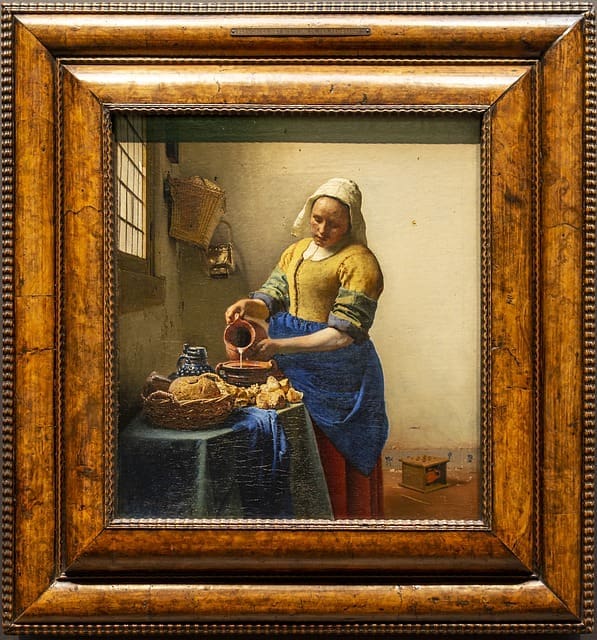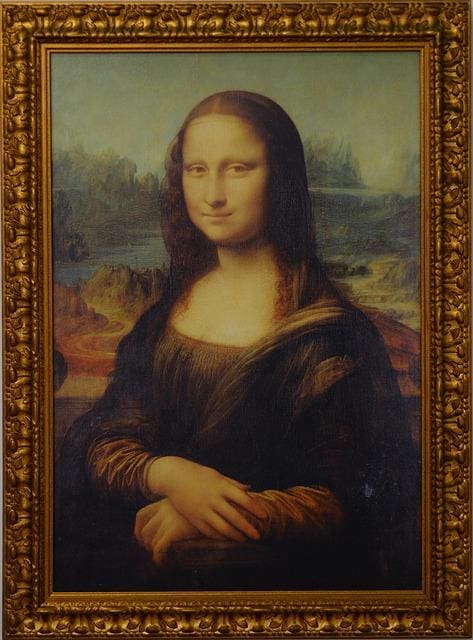Talking about politics or religion may be compared to asking about art. Battles have been lost, friendships have broken up. After a contentious disagreement, an estranged lover is apparently- forced to sleep on the sofa. It’s simply so intimate.
Passion is sparked by art. Inspiring action is art. Life is inspired by art.
Trying to analyze how painting inspires is not something you can question carelessly, whether it be serious, amusing, silly, quirky, or completely ludicrous. You may be inspired on how to enhance your photography by studying the renowned portrait paintings talked about below.
Leonardo da Vinci’s Mona Lisa (1503-1506)
One of the most well-known portraits in fine arts is the Mona Lisa; the technical details and the topic have generated a great deal of fascination throughout the years. To go into detail about each component would require a whole essay. So instead, this just shows you how special the painting is.
The Mona Lisa forms a triangle in the oil painting’s arrangement, as you can see. She is supported by her arms, which serve as the triangle’s top point and may be reached by following the arms as leading illustrations.
Her unique stance, which is three-quarters and facing the spectator with relaxed crossed arms, is still quite popular today. Consider how the light from the upper left generates sufficient contrast between the lights and shadow to give the picture depth.
Rembrandt’s Self-portrait (1660)
Rembrandt van Rijn is regarded as the visual artist of light and is mostly known for his masterful portraits. He used only dark earth tones since he believed light should always be the primary topic. Rembrandt employed light to emphasize skin texture and portray emotion via expression in his search for truth and realism.
There is no finer “mentor” for photographers or upcoming artists than Rembrandt. Like in Rembrandt’s paintings, a light triangle behind the subject’s eye distinguishes the Rembrandt lighting technique used in portrait photography.
The feat becomes even more astonishing given that Rembrandt painted himself for this picture, which was undoubtedly tricky in the era before photographs.
Adele Bloch Bauer’s portrait Gustav Klimt (1907)
Starting, Gustav Klimt completed private commissions to paint murals on governmental structures. Later, after 1900, he concentrated on painting portraiture for the Jewish Vienna society, a young set of industrialists who proved to be art enthusiasts and his most prominent supporters. Finally, by defying convention and helping to form the Vienna Secession, Klimt cemented his reputation as a painter of attractive ladies.
Although he produced hundreds of preliminary sketches for the paintings, Adele Bloch Bauer is shown in just two of the portraits. The first two paintings are oil paintings with gold and silver leaves. He was influenced by the Arts and Crafts movement, Art Nouveau, and the mosaics created by Byzantine artists in Ravenna.
His works are the ideal illustration of how interdisciplinary research and multimedia methodologies may produce effective outcomes.
Unfortunately, the original paintings are often very expensive, but oil painting reproductions provide an affordable option for people who still want to own a piece of art. While there are many reproduction paintings available on the market, it is important to find quality oil painting reproductions that will look like the original.
Herman von Wedigh III by Hans Holbein the Younger (1532)
Prior to painting his subjects, Hans Holbein, often known as the Younger to separate himself from his painter father, sketched them. He used to draw with chalk and silverpoint. He then copied the drawing onto a panel and began painting using tempera and oil.
Wedigh was an expert in both methods of color. He employs green in the forefront and blue in the backdrop to highlight the person in black, as seen in the Herman von Wedigh III picture above. On the color wheel, the primary color blue and the secondary color green form an analogous color combination. You may study the color theory technique applied in this photo and use it in your general photographs and portraiture.
Portrait of a Young Woman by Edgar Degas (ca. 1885)
In art history, photography and impressionism are related. The advent of photography freed artists from the necessity of representing things “as they are.” It allowed them to begin creating “impressions” of how things seemed to them.
Of course, this didn’t happen straight away. Although we have images dating back at least to 1826, the actual discovery of photography was in 1839. The impressionist movement flourished in the 1870s and 1880s.
Famous impressionist painter Edgar Degas was one of the significant painters during this time. Ballerinas are the subject of his most well-known paintings, which he first managed to capture in photographs.
As per the National Gallery of Art, one can tell that photography significantly impacted his style since the bodies are chopped off and positioned off-center. High and oblique sightlines are present. All the notable portraits in this book have affected photographs of our day, demonstrating how art and photography have enhanced each other over time.
The Milkmaid, Johannes Vermeer (ca.1658 – estimation by the Rijksmuseum)
A prominent genius of the Dutch Golden Age is Johannes Vermeer. The majority of his paintings include typical residential settings of regular people. Among his universally acclaimed paintings is The Milkmaid, sometimes widely referred to as The Kitchen Maid.

Since Vermeer was unearthed by art historians and received the acclaim he deserved in the nineteenth century, it has served as an inspiration to several painters. In addition, Vermeer’s collection of well-known portraits offers a wealth of compositional, lighting, and posing lessons for those who like lifestyle photography.
Conclusion
Several of these paintings have captured the interest of art enthusiasts for years because they are stunning and contain unanswered questions and well-kept secrets. Even though many hypotheses regarding the genuine meaning or potential interpretations have been disproven, only the original artists may genuinely understand what they meant. But it’s nevertheless evident that they serve as a great source of inspiration for art enthusiasts.
Featured Image by Rudy and Peter Skitterians from Pixabay




